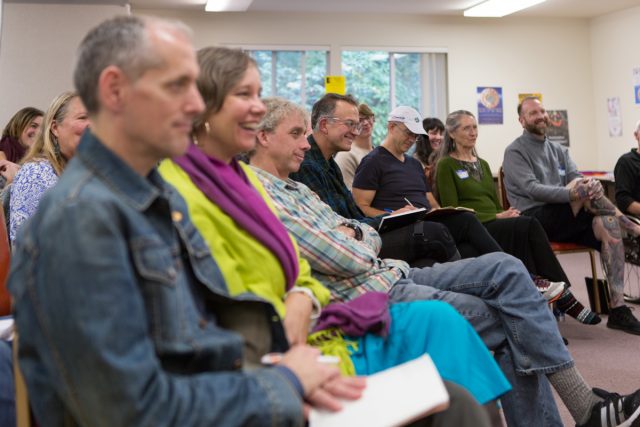Leaders of Buddhist-based addiction approaches gathered in Washington state October 20–22 for the Buddhist Recovery Summit 2017. Their gathering was timely: addicts seeking freedom from drugs and alcohol are increasingly turning to Buddhist-based recovery groups for help, and the rising wave of opioid addiction in the United States and Canada is causing increasing demand for new responses beyond the usual milieu of Alcoholics Anonymous (AA) recovery groups.
At the event, organized by the Northwest Dharma Association, more than 100 people from around the world met at a Christian retreat center near Washington’s capital city of Olympia. They shared their progress in applying the Buddha’s teachings to addiction recovery and planned to make more Buddhist recovery groups available to more people.
Most of those attending were Buddhist, and many were meeting in person for the first time, often after years of collaborating online.
“It was very fruitful, primarily due to the fact that we have not had a meeting like that since 2009, since we really got the Buddhist recovery community together in a meaningful way,” said George Johns, president of the Buddhist Recovery Network (BRN), one of the organizations at the summit.
Buddhist Recovery Network has emerged as a go-to place for people seeking a Buddhist approach to fighting addiction. The umbrella organization now includes more than 250 recovery groups of many types on its website, less than a decade after its founding, and the number of groups continues to climb. The intent of the network’s website is to offer all approaches to people without bias, to help them find meetings where they live.
“There is an audience out there that is looking for effective recovery techniques, and BRN is speaking to that need,” Johns said.

Related: Using the Buddha’s Teachings to Overcome Addiction
The complex relationship between the fast-growing Buddhist recovery approaches— including Noah Levine’s Refuge Recovery program, Vimalasara’s Eight Step Recovery method, and Vince Cullen’s Hungry Ghost recovery retreats—and the 84-year-old AA movement was a central topic that emerged throughout the summit. While the Buddha’s teachings are expressed somewhat differently in the various groups’ programs, they are all without the theistic overtones found in traditional 12-step addiction recovery work, something that is attractive to many non-theistic people seeking relief from addiction.
Many at the summit have been AA participants for years and credited AA with their own recovery; it was often repeated during the event that nobody has to choose between AA and the Buddhist groups.
“I’m so grateful for being in both of these lineages,” said Barbara West, a Shambhala practitioner and poet from Davis, California. “Sometimes the Christian level of 12-step helps me get to the Buddhist goal I’m trying to get to. People aren’t seeing it as an either-or.”
Still, the rising secularization of U.S. society has attracted some addicts away from the 12-step approach to Buddhist alternatives, even when they aren’t Buddhist themselves, conference leaders suggested.
“There’s a burst of energy; it’s the next wave,” said Vimalasara. “It’s really important for us to let the wider world know that this is an alternative to the 12-step model, or a complement to the 12-step model.”
Related: The Suffering of Addiction
Lindsay Shea, a chemical dependency professional from Seattle, said she’s increasingly referring non-Buddhist people to Buddhist recovery groups.
“The biggest block I encounter with people with 12-step is the view that it’s Judeo-Christian in nature, and a lot of people have had bad experiences with religion and church,” she said. “Buddhist recovery doesn’t have the same connotation for them. . . . In my personal and professional experience, the different Buddhist recovery groups are incredibly inclusive.”
The heart of the Buddhist Recovery Summit was October 21, a daylong marathon that started with a 7 a.m. silent meditation. The day included two panels and two small group discussions, while a drenching rain continued outside in true Northwest fashion.
On Saturday morning summit-goers were able to choose among four different styles of recovery meetings: Refuge Recovery, Sit and Share, Noble Steps, and Eight Steps. It was an opportunity to try new approaches to witnessing their addictions and supporting each other in recovery.
And while the event featured the big names in the Buddhist recovery movement, those people seemed to downplay their own importance. Levine was probably the highest-profile person there, whose father is the late Stephen Levine, also a well-known Buddhist teacher and author. But Levine also seemed to be pushing away personal attention.
“My hope is that the Buddhist recovery movement is bigger than any of its personalities,” he said. “I feel very interested in, and committed to, getting out of the way.”
Johns said he emerged from the summit re-invigorated about the importance of the work Buddhists are doing to help people free themselves from all forms of addiction.
“At the core of the Buddhist teachings is mindfulness and the way out of suffering,” he said in a closing statement. “Buddhist recovery offers a host of teachings and practices to live a life free from the misery of addictions, and BRN is committed to nurturing and disseminating these ideas to help the still-suffering addict.”
Related: Recovery and the Fifth Precept